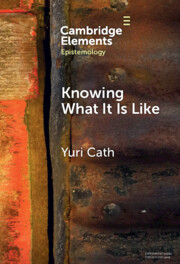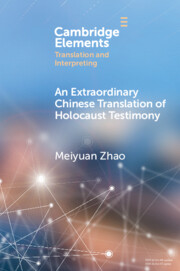Refine search
Actions for selected content:
128 results
Digital Dybbuks and virtual Golems: the ethics of digital duplicates in Holocaust testimony
- Part of
-
- Journal:
- Memory, Mind & Media / Volume 4 / 2025
- Published online by Cambridge University Press:
- 11 August 2025, e10
-
- Article
-
- You have access
- Open access
- HTML
- Export citation
Being Rational about Radical Environmentalism: A Response to Simpson and Handfield
-
- Journal:
- Episteme , First View
- Published online by Cambridge University Press:
- 07 August 2025, pp. 1-8
-
- Article
-
- You have access
- Open access
- HTML
- Export citation
Chapter 6 - Landscapes of Memory
-
- Book:
- Healing and the Invention of Metaphor
- Published online:
- 17 July 2025
- Print publication:
- 31 July 2025, pp 146-174
-
- Chapter
- Export citation

Testimony and Historical Knowledge
- Authority, Evidence and Ethics in Historiography
-
- Published online:
- 29 July 2025
- Print publication:
- 21 August 2025
-
- Element
-
- You have access
- Open access
- HTML
- Export citation
The Epistemic Significance of Mind-Changing
-
- Journal:
- Episteme , First View
- Published online by Cambridge University Press:
- 28 July 2025, pp. 1-19
-
- Article
-
- You have access
- Open access
- HTML
- Export citation
4 - Testimony as a Response to Mass Atrocity: 1940s to the Present
- from Part I - History
-
-
- Book:
- The Cambridge History of the Holocaust
- Published online:
- 16 May 2025
- Print publication:
- 12 June 2025, pp 103-120
-
- Chapter
- Export citation
10 - How Does Children’s Memory Work?
- from Section II - Middle Childhood
-
- Book:
- Child Development
- Published online:
- 19 June 2025
- Print publication:
- 12 June 2025, pp 150-165
-
- Chapter
- Export citation
17 - The Holocaust and Digital Humanities
- from Part III - Culture and Ideas
-
-
- Book:
- The Cambridge History of the Holocaust
- Published online:
- 16 May 2025
- Print publication:
- 12 June 2025, pp 398-420
-
- Chapter
- Export citation
Does the emotional framing of narratives influence attitudes? Evidence from second-hand testimonies on WWII collaboration and repression
- Part of
-
- Journal:
- Memory, Mind & Media / Volume 4 / 2025
- Published online by Cambridge University Press:
- 03 June 2025, e6
-
- Article
-
- You have access
- Open access
- HTML
- Export citation
6 - Eradicating Ethos
- from Part III - Façade of Neutrality
-
-
- Book:
- Rhetorical Traditions and Contemporary Law
- Published online:
- 02 May 2025
- Print publication:
- 22 May 2025, pp 119-138
-
- Chapter
-
- You have access
- Open access
- HTML
- Export citation
Chapter 2 - The Ornamental, the Polemical, and the Testimonial
-
-
- Book:
- The Cambridge Companion to Mary Prince
- Published online:
- 24 April 2025
- Print publication:
- 08 May 2025, pp 37-51
-
- Chapter
- Export citation
A Case for Caregiver Testimony about the Cognitively Disabled
-
- Journal:
- Episteme , First View
- Published online by Cambridge University Press:
- 24 March 2025, pp. 1-15
-
- Article
-
- You have access
- Open access
- HTML
- Export citation
Transmitting Knowledge and Gaining Recognition: Chinese “Comfort Women” Reparation Trials in the 1990s and 2000s
-
- Journal:
- Asia-Pacific Journal / Volume 19 / Issue 5 / March 2021
- Published online by Cambridge University Press:
- 14 March 2025, e4
-
- Article
-
- You have access
- Open access
- Export citation
There is no fresh air: A problem with the concept of echo chambers
-
- Journal:
- Episteme , First View
- Published online by Cambridge University Press:
- 04 March 2025, pp. 1-19
-
- Article
-
- You have access
- Open access
- HTML
- Export citation
“A Kind of Literary Archeology”: Excavating Morocco’s Slave Past under the Protectorate (1912–1956)
-
- Journal:
- African Studies Review / Volume 68 / Issue 1 / March 2025
- Published online by Cambridge University Press:
- 19 February 2025, pp. 91-110
-
- Article
-
- You have access
- Open access
- HTML
- Export citation
Gratitude and the web of knowledge
-
- Journal:
- Episteme , First View
- Published online by Cambridge University Press:
- 27 January 2025, pp. 1-16
-
- Article
-
- You have access
- Open access
- HTML
- Export citation
Social virtue epistemology and epistemic exactingness
-
- Journal:
- Episteme , First View
- Published online by Cambridge University Press:
- 27 January 2025, pp. 1-16
-
- Article
-
- You have access
- Open access
- HTML
- Export citation
Beyond testimony: Sharing epistemic resources
-
- Journal:
- Episteme , First View
- Published online by Cambridge University Press:
- 22 January 2025, pp. 1-11
-
- Article
-
- You have access
- Open access
- HTML
- Export citation

Knowing What It Is Like
-
- Published online:
- 02 December 2024
- Print publication:
- 19 December 2024
-
- Element
- Export citation

An Extraordinary Chinese Translation of Holocaust Testimony
-
- Published online:
- 25 November 2024
- Print publication:
- 09 January 2025
-
- Element
- Export citation
